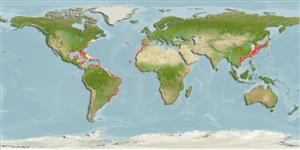أشلاق (القروش و الشفانين) (sharks and rays) >
Squaliformes (Sleeper and dogfish sharks) >
Dalatiidae (Sleeper sharks)
Etymology: Isistius: Etymology not explained, probably iso-, from isos (Gr.), equal; istius, from histion (Gr.), sail (i.e., dorsal fin), referring to its two similarly shaped and sized (and posterior) dorsal fins, a character Gill used to diagnose genus. José I. Castro, The Sharks of North America (Oxford University Press, 2011), suggests name may allude to the Egyptian goddess Isis, represented in statuary with her head veiled, or to the dark collar encircling throat of I. brasiliensis, “which could also suggest a veil over the head” (p. 145). This interpretation is rejected by the fact that Gill often used “istius” in the names of several genera distinguished (at least in part) by their dorsal fins (Acanthistius, Brachyistius, Caristius, Dichistius, Goniistius, Iniistius, Micromesistius, Nematistius). (See ETYFish); plutodus: ploutos (Gr.), wealth or abundance; odon (Gr.), tooth, referring to larger size of lower jaw teeth compared with congeners. (See ETYFish).
Environment: milieu / climate zone / depth range / distribution range
البيئة
بحري; نطاق العمق 60 - 200 m (Ref. 52580). Subtropical; 44°N - 33°S (Ref. 52580)
Atlantic: off Alabama, USA and the Gulf of Mexico; including Brazil and West Sahara and off Azores. Northwest Pacific: off Okinawa, Japan and Australia (NSW). A very rare species (Ref. 52580).
الحجم / وزن / العمر
Maturity: Lm ? range ? - ? cm
Max length : 42.3 cm TL (female)
الأشواك الظهرية (المجموع) : 0. The largetooth cookiecutter shark Isistius plutodus has no collar marking around throat, a small asymmetrical caudal fin with a short ventral lobe less than half the length of dorsal caudal margin, bigger mouth and gigantic lower teeth (proportionately the largest in any living shark) in 19 rows (upper teeth = 29 rows). Eyes set well forward on head, with extensive anterior binocular field. Pectoral fins rounded, pelvic fins smaller than dorsal fins.
As with the other member of the genus Isistius, it has a characteristic small cigar-shaped body with two small close-set spineless dorsal fins far posterior on back, no anal fin, huge, triangular-cusped teeth without blades, short, bulbous snout and a unique suctorial lips (Ref. 247).
A very rare species known only from few localities in epipelagic waters. Apparently feeds on small epibenthic and epipelagic invertebrates and fish. Its powerful jaws, big mouth and enormous lower teeth enable it to bite off large portion of its prey in one sweeping motion. A facultative ectoparasite evidenced by its suctorial lips and feeding apparatus. It has extremely short snout and anteriorly positioned eyes which allows for binocular vision (Ref. 247). Caught by mid-water trawl (Ref. 55584). Ovoviviparous (Ref. 205). Has large oily liver which helps it to become neutrally buoyant (`hepatic float').
Life cycle and mating behavior
Maturities | التكاثر | Spawnings | Egg(s) | Fecundities | Larvae
Distinct pairing with embrace (Ref. 205).
Compagno, L.J.V., 1984. FAO Species Catalogue. Vol. 4. Sharks of the world. An annotated and illustrated catalogue of shark species known to date. Part 1 - Hexanchiformes to Lamniformes. FAO Fish. Synop. 125(4/1):1-249. Rome, FAO. (Ref. 247)
IUCN Red List Status (Ref. 130435)
استخدامات بشرية
مصائد: غير ذات اهمية
أدوات
تقارير خاصة
Download XML
مصادر علي الأنترنت
Estimates based on models
Preferred temperature (Ref.
123201): 14.1 - 25.1, mean 18.8 °C (based on 225 cells).
Phylogenetic diversity index (Ref.
82804): PD
50 = 0.7520 [Uniqueness, from 0.5 = low to 2.0 = high].
Bayesian length-weight: a=0.00372 (0.00141 - 0.00976), b=3.12 (2.89 - 3.35), in cm total length, based on LWR estimates for this (Sub)family-body shape (Ref.
93245).
مستوى غذائي (Ref.
69278): 4.2 ±0.4 se; based on size and trophs of closest relatives
المرونه (Ref.
120179): منخفض, الحد الزمني الأدني لتضاعف عدد أفراد المجتمع 4.5-14 سنة (Fec assumed to be <100).
Fishing Vulnerability (Ref.
59153): Low to moderate vulnerability (32 of 100).
